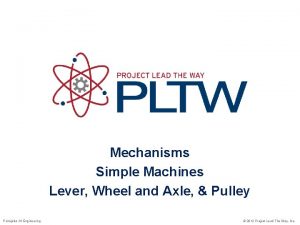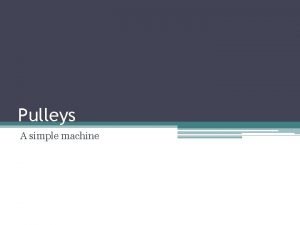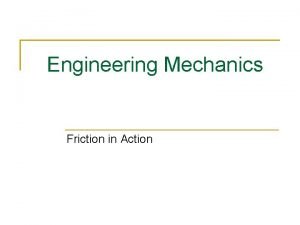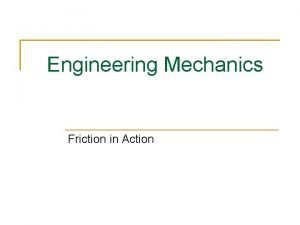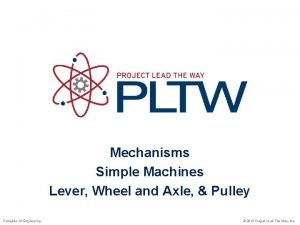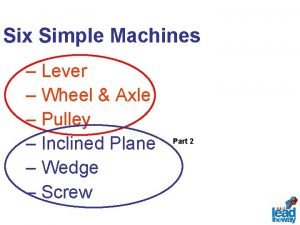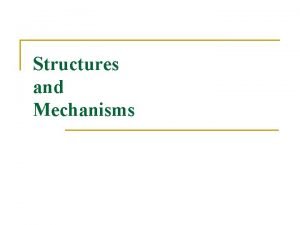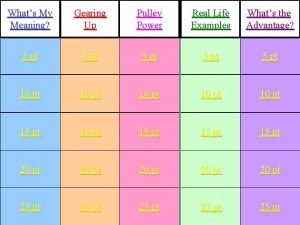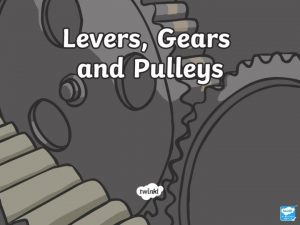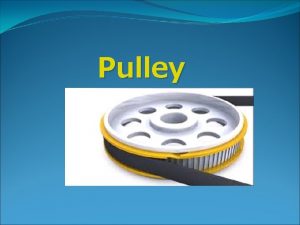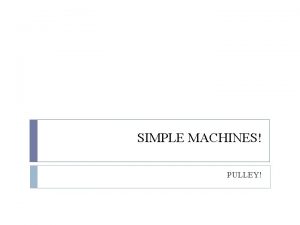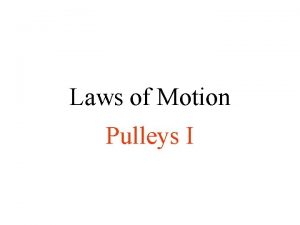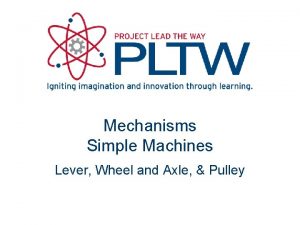Structures and Mechanisms Pulleys A pulley wheel is












- Slides: 12

Structures and Mechanisms

Pulleys A pulley wheel is a mechanism which helps move or lift objects. pulley Exercise machine

Pulleys Parts of a Pulley System Direction of Force Notice that the pulleys change the direction of the applied force.

Pulleys Types of Pulley. 1. A fixed pulley A ski lift operates on a fixed pulley system

Pulleys 2. A moveable pulley - rises and falls with the load being moved. Moveable pulley

Pulleys 3. A block and tackle Consists of two or more pulleys (fixed and moveable). Block and tackle

Pulleys The Pulley Advantage In this simple pulley system, the force is equal to the load, so the Mechanical Advantage is 1: 1 or 1. 10 Kg = 100 N The Mechanical Advantage is calculated like so: Mechanical Advantage = Load / Effort = 100 N / 100 N Mechanical Advantage = 1: 1 or 1

Pulleys The Pulley Advantage Each side of the rope carries half the load. Therefore, the force required by the person to keep the load in equilibrium is also half the load. This system has a Mechanical Advantage of 2: 1 or 2. 10 Kg = 100 N The Mechanical Advantage is calculated like so: Mechanical Advantage = Load / Effort = 100 N / 50 N Mechanical Advantage = 2: 1 or 2

Pulleys The Pulley Advantage This system has a Mechanical Advantage of 4: 1 or 4. 10 Kg = 100 N The Mechanical Advantage is calculated like so: Mechanical Advantage = Load / Effort = 100 N / 25 N Mechanical Advantage = 4: 1 or 4

Pulleys The Pulley Advantage This system has a Mechanical Advantage of 4: 1 or 4. 200 Kg = 2000 N The Mechanical Advantage is calculated like so: Mechanical Advantage = Load / Effort = 2000 N / 500 N Mechanical Advantage = 4: 1 or 4

Pulleys Pulley drives: Using pulleys to transmit motion and force: ? Pulleys and Belts Toothed Belt and Pulleys

Pulleys Pulley drive calculations: Driver 40 mm Dia. Driven 70 mm Dia. 280 rev/min ? rev/min Driven will rotate slower than the driver. Calculation: Speed ratio = Diameter of Driver pulley Diameter of Driven pulley Speed of Driven pulley = 280 x 40 = 40 70 = 160 rev/min 70 How could you change the direction of rotation of the driven pulley ?
 Pulley lever wheel and axle
Pulley lever wheel and axle Pulleys uses
Pulleys uses A flat belt connects pulley a to pulley b
A flat belt connects pulley a to pulley b Belt friction formula
Belt friction formula Wheel and axle clipart
Wheel and axle clipart Pulley ama
Pulley ama Leb
Leb Virtualization structure in cloud computing
Virtualization structure in cloud computing Structure and mechanism
Structure and mechanism Examples of homologous
Examples of homologous Examples of block and tackle pulleys in real life
Examples of block and tackle pulleys in real life Gmail
Gmail Gears pulleys and levers
Gears pulleys and levers
